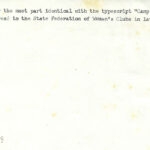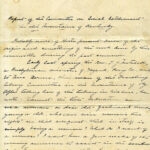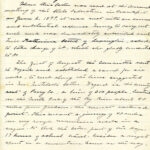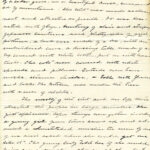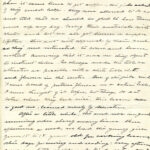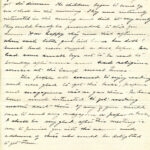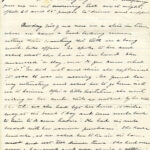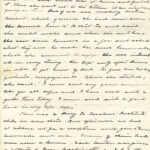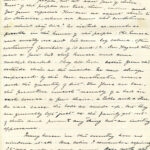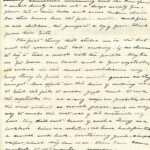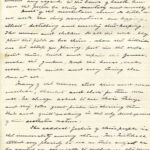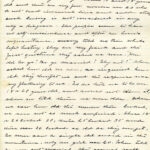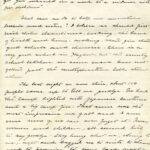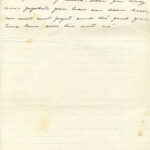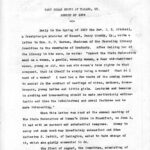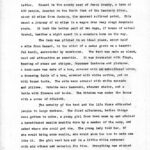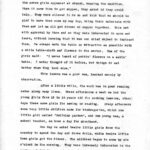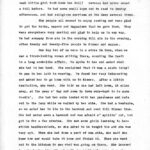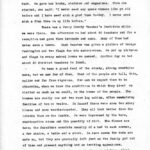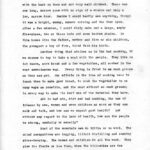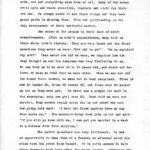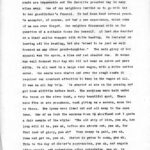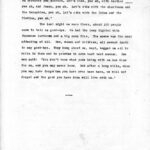Pine Mountain Settlement School
Series 09: Biography – Directors
Katherine Pettit
WRITING
c.1899-1900 Camp Cedar Grove Report
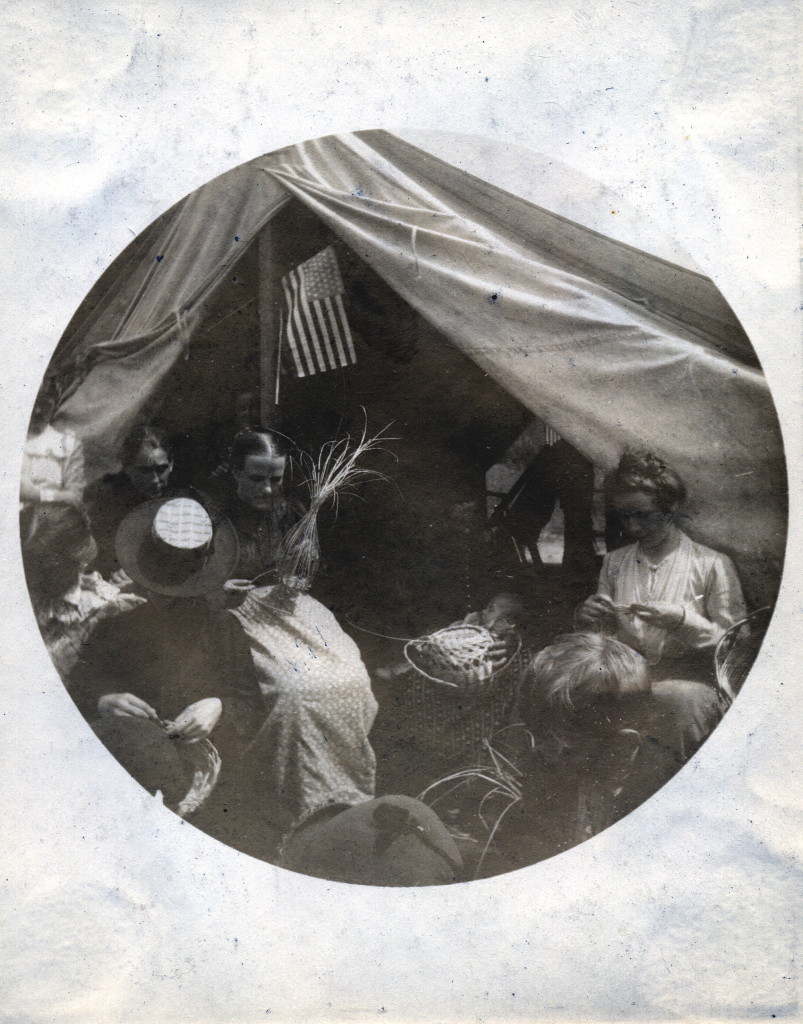
TAGS: Katherine Pettit ,1899-1900, Camp Cedar Grove, Report of the Committee on Social Settlements in the Mountains of Kentucky, State Federation of Women’s Clubs, Hazard KY, Traveling Library Committee, Mrs. C.P. Barnes, May Stone, Rae M. McNab, Mary E. McCartney, Sassafras, KY, mountain people, literacy, libraries, Rev. J.T. Mitchell, Perry County Teachers Institute, community residents, cooking lessons, sewing lessons, teachers, tobacco use, preachers, funerals, sermons
KATHERINE PETTIT WRITING 1899-1900 Camp Cedar Grove Report
Katherine Pettit 1899-1900 Camp Cedar Grove Report: Introduction
(“Report of the Committee on Social Settlements in the Mountains of Kentucky”)
In the spring of 1899, while Miss Katherine Pettit, the co-founder of Pine Mountain Settlement School, was attending an annual meeting the State Federation of Women’s Clubs in Frankfort, Kentucky, she heard an appeal for social settlements that she could not resist. A letter from a Presbyterian minister in Hazard, Kentucky, [Rev. Mitchell] was read at the meeting that had an urgent, and now much quoted request:
Cannot the State Federation send us a woman, a gentle, womanly woman, a dear old-fashioned woman, young or old, who can win woman’s true rights in that conquest, that in itself is simply being a woman? I want her a few weeks of the coming Summer to assist in the conduct of meetings of wives, mothers, housekeepers, young ladies and little girls. Lectures and lessons in cooking and home-making should be made particularly enthusiastic and then the intellectual and moral features can be made interesting.
Report of the Committee on Social Settlements in the Mountains of Kentucky, presented at the State Federation of Women’s Clubs annual meeting, c. 1899. Possibly written by Katherine Pettit.
Consequently, a committee consisting of Miss Pettit and three other Federation members, including May Stone; Rae M. McNab; and Mary E. McCartney, all from Louisville, Ky, set up a camp in Hazard for six weeks in August to address the needs of the mountain people that were described in the minister’s letter. A photograph album was assembled of the following 1901 summer experiment at Sassafras, Kentucky, nearby, that followed the Cedar Grove model. That photograph album is titled the Sassafras Album and some images from that later camp are included on this page that describes Cedar Grove. The summer camp project was a success and also eye-opening for the women who ran the camp. So much so that, upon their return, a stirring report was submitted to the Federation, detailing the committee’s work as well as the unique culture that they had encountered. Miss Pettit’s experience with this camp, known as Camp Cedar Grove, and the next year at Sassafras, most likely contributed to her desire to co-found Pine Mountain Settlement School in Harlan County some thirteen years later.
The original handwritten document detailing the early social uplift endeavor, and reproduced below, appears to be the only one now in existence. It is held in the Pine Mountain Settlement School Collections.
KATHERINE PETTIT 1899-1900 Camp Cedar Grove Report: Transcription and Digitization of original document
The original handwritten document and the accompanying carbon copy of a typewritten transcription have two titles. Besides the title above (“Report of the Committee on Social Settlements in the Mountains of Kentucky”), another transcription has an assigned title of “Camp Cedar Grove.”
Although the author is not designated, the handwritten document resembles the script of Katherine Pettit. However, the handwriting is far more compact than her later scrawl and Pettit may not have penned the document. While preparing for his dissertation about Pine Mountain, Dr. James Greene III inspected the report and noted that it was “for the most part identical with the typescript,” and that, “It was evidently read to the State Federation of Women’s Clubs in late 1899 or early 1900.”
The handwritten document and its typescript were scanned in 2019 and both were then re-scanned in 2021. Both digital copies are watermarked accordingly. The transcription and images below are that of the second scan. This second set includes images of the original handwritten report with the filename, “camp_cedar_grove”, and its typescript, “camp_cedar_grove_trans”.
KATHERINE PETTIT 1899-1900 Camp Cedar Grove Report: TRANSCRIPTION
[NOTE: Text has been slightly edited for clarity.]
[000] The [handwritten] report is for the most part identical with the typescript “Camp Cedar Grove.” It was evidently read to the State Federation of Women’s Clubs in late 1899 or early 1900. 7/75 JSG (Dr. James S. Greene III)
[01] Page 1
CAMP CEDAR GROVE AT HAZARD, KY
SUMMER OF 1899
Early in the Spring of 1899 the Rev. J.T. Mitchell, a Presbyterian minister of Hazard, Perry County, Ky., wrote a letter to Mrs. C.P. Barnes, Chairman of the Traveling Library Committee in the Mountains of Kentucky. After telling her of the library in his care, he wrote:
*Cannot the State Federation send us a woman, a gentle, womanly woman, a dear old-fashioned woman, young or old, who can win woman’s true rights in that conquest, that in itself is simply being a woman? What do I want of a woman? I want her a few weeks of the coming Summer to assist in the conduct of meetings of wives, mothers, housekeepers, young ladies and little girls. Lectures and lessons in cooking and home-making should be made particularly enthusiastic and then the intellectual and moral features can be made interesting.
Rev. J.T. Mitchell, Hazard, Kentucky, in an 1899 letter to Mrs. C.P. Barnes, Chairman of the Traveling Library Committee in the Mountains of Kentucky.
When this letter was read at the annual meeting of the State Federation of Women’s Clubs in Frankfort, on June 2, it met with an earnest and substantial response. Money to carry out such work was immediately subscribed and Miss Katherine R. Pettit, of Lexington, [was] asked to take charge of it, which she gladly consented to do.
The first of August, the committee, consisting of four members, went to Hazard and established a Camp for six weeks, to work along the lines suggested in Mr. Mitchell’s*
[02] Page 2
letter. Hazard is the county seat of Perry County, a town of 600 people, located on the North Fork of the Kentucky River, about 40 miles from Jackson, the nearest railroad point. This meant a journey of 40 miles in a wagon over very rough mountain roads. It took the better part of two days, 17 hours of actual travel, besides a night spent in a mountain home on the way.
The Camp was pitched in an ideal place, about half a mile from Hazard, in the midst of a cedar grove on a beautiful knoll, surrounded by mountains. The tent was made as clean, neat and attractive as possible. It was decorated with flags, bunting of stars and stripes, Japanese lanterns and pictures. A book-case was made of a box, covered with an embroidered cover, a dressing table of a box, covered with white cotton, put on with brass tacks. The cots were covered with white spreads and pillows, Outside were hammocks, steamer chairs, and a table with flowers and books. The kitchen was under the trees with a cover of oilcloth.
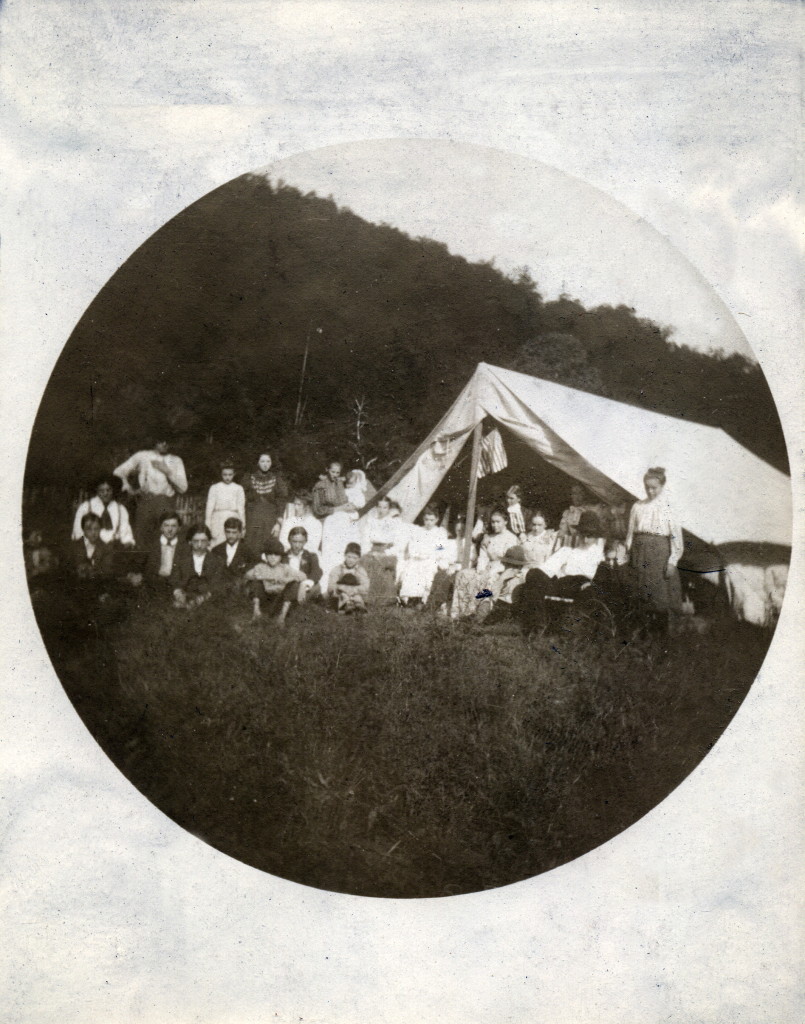
The novelty of the tent and the life there attracted people in large numbers. The first afternoon, before things were gotten in order, a young girl from town came up and admired a hemstitched muslin necktie worn by a member of the camp, and asked where she could get one. The young lady told her, if she would bring some muslin, she would show her how to make one like it. The girl went home and in a little while returned with six others and material for ties. Everything was stopped to teach these girls to hemstitch and the next Sunday morning,
[03] Page 3
the seven girls appeared at church, wearing the neckties. When it came time to get supper, they asked if they could help. They were allowed to do so and told that we should be glad to have them come up any day, bring their materials with them and let us all get dinner or supper together. This met with approval by them and so they were interested to come and learn, without knowing that it was our chief object to instruct them. We always made the table as attractive as possible with a white table-cloth and flowers in the center, One of the girls said: “I never heard of puttin’ flowers on a eatin’ table. I never thought of it before, but things do eat better when they look nice.”
This lesson was a good one, learned merely by observation.
After a little while, the work was in good running order along many lines. Three afternoons a week we had the young girls from 15 to 18 years old for cooking lessons, other days these same girls for sewing or reading. Every afternoon some very little children came for kindergarten, which one little girl called “MoKinley garden”, and one young man, a school teacher, an hour a day for shorthand.
One day we asked twelve little girls from the country to spend the day and dress dolls, while twelve little town girls got the dinner. The children began to come by six o’clock in the morning. They were intensely interested in the sewing and did it very nicely. They could hardly be persuaded to stop for dinner. How happy they were that afternoon, when
[04] Page 4
each little girl took home her doll! Several had never owned a doll before. We had some small boys out to read to Sunday afternoons, and had religious services at the Camp several times.
The people all seemed to enjoy reading and were glad to get the books, papers and magazines that we gave them. They were everywhere very cordial and glad to help us in any way. We had company from six in the morning till six in the evening, often twenty and twenty-five people to dinner and supper.
One day two of us were in a store in town, when we saw a tired-looking woman sitting there, counting the teeth in a long comb-like affair. We spoke to her and asked what she had in her hand. She explained that it was a slade (sley) to use in her loom in weaving. We found her very interesting and asked her to go home with us to dinner. After a little hesitation, she went. She told us she had left home, 15 miles away, at the peep o’ day and come to town mule-back to do some tradin’. She had her mule loaded with her purchases and rode out to the Camp while we walked by her side. She had a headache, so we asked her to lie in the hammock and rest till dinner time. She had never seen a hammock and was afraid o’ spillin’ out, but got in for a few minutes. She saw some girls learning to hemstitch handkerchiefs, so she asked to be taught too and she was very apt. When she had done a part of one side, she said she knew how and would take it home and finish it. Then she went out to the kitchen to see what was going on there. She learned to make beaten biscuit and said she would make some when she went home. She left early after dinner in order to get home by
[05] Page 5
dark. We gave her books, pictures and magazines. When she started [to leave], she said: “I never seed any quare wimmen like ye all before and I have seed sich a good time to-day. I never seed sich a fine time in my life before.”
There was a Perry County Teachers’ Institute while we were there. One afternoon we had about 60 teachers out for a reception and gave them lemonade and cake. Many of them had never seen a lemon. Each teacher was given a picture of George Washington and two flags for his school-room. We put up pictures and flags in every school house we passed. Another day we had about 20 district teachers to lunch.
We hear a great deal of the sturdy, strong mountaineers, but we saw few of them. Most of the people are tall, thin, sallow and far from vigorous. How can we expect them to be otherwise, when we know the conditions in which they live? We visited as much as we could, in the homes of the people. The houses are mostly one and two room log cabins, often containing families of ten or twelve. In Hazard there were some two story houses and some weatherboarded. They all look better from the outside than on the inside. We were impressed by the bare, unattractive rooms and the quantity of dirt. The floors are bare; the furniture consists usually of a bed in each corner, a few chairs, a table and a stove. In rare cases the beds are made up, but they are generally left just as the family get out of them and present anything but an inviting appearance.
Many houses in the country have no windows at all. One cabin I remember especially. It was made of rough, round logs
[06] Page 6
with the bark on them and not very well chinked. There was one long, narrow room with no sign of a window and only a low, narrow door. Inside I could hardly see anything, though it was a bright, sunny, summer morning and the door open. After a few minutes, I could dimly make out a large, empty fire-place, two or three beds and some broken chairs. In this house live the father, mother and five or six children, the youngest a boy of four, blind from his birth.
Another thing that strikes us is the bad cooking, if we chance to try to take a meal with the people. They live on fat bacon, corn bread and a few vegetables, all cooked in the most unwholesome way. Every thing is fried in as much grease as they can get. Our efforts in the line of cooking were to teach them to make good bread, to cook the vegetables in as many ways as possible, and the meat without so much grease; in every way to make the best use of the material they have.
Add to bad air, dirt and bad cooking. the use of tobacco by men, women and even children as soon as they can walk and talk, and how can we expect good health? And without any regard to the laws of health, how can the people be strong, mentally or morally?
Most of the mountain men do little or no work. The chief occupations are logging, illicit distilling and country store-keeping. The women and children do all the work. They plow the fields or hoe them, when the hill-sides are too steep for plowing. put in the crops, ‘tend them, build and repair the fences, make the garden, keep the house, cook, wash,
[07] Page 7
milk, sew and everything else done at all. Many of the women still spin and weave coverlids, blankets and cloth for their own use. We always asked to see these things and they take great pride in showing them. This and quilt-making is the only development of their aesthetic nature,
One charm of the people is their lack of self-consciousness. After an hour’s acquaintance, many told us their whole life’s history. They are very frank and the first questions they asked us were: “How old be ye?” “Be ye married? Why not?” When asked how old we were, we inquired how old they thought us and the response was very flattering to us. No one took us to be over 18 or 20 years old, and would not believe it when we told them we were older. When we saw how old the women there looked, we were not so much surprised. Those 18 and 20 looked 30, those 25 looked 35, and those over 30 looked as old as they ever get. We never saw a single old maid in the mountains, only one girl over 20. When told we were not married, they seemed really sorry for us and asked why not. One young lady said: “I have not found anybody down my way that wants me.” The mountain woman took pity on her and said: “If you will go home with me, I can get you married in a week to a widower with five children.”
The native preachers are very illiterate. We had an opportunity to hear them at a funeral we attended about six miles down the river from Hazard. It is quite common to have these funerals held long after the death occurs, sometimes the
[08] Page 8
roads are impassable and the favorite preacher may be many miles away. One of our neighbors invited us to go with her to her grandfather’s funeral. He had been dead several years. We accepted, of course, and had a new experience, which none of us can ever forget. Our neighbor discussed with us the question of a suitable dress for herself. At last she decided on a black calico wrapper with white beading. We insisted on leaving off the beading. but she “aimed to be jest as well dressed as any other grand-daughter.” the main glory of her apparel was the apron, a blue and red checked one. No woman was well dressed that day who did not wear an apron and yarn mitts. We all went in a large road wagon, with a white cotton cover. Our seats were chairs and over the rough roads it required our constant attention to keep in the wagon at all. It was an all day trip. We started at six in the morning and got home at little before dark. The services were held under the trees on the river bank, a very beautiful spot. There were five or six preachers, each giving us a sermon, some two or three. The hymns were lined out and all sung to the same tune. One of us took the sermons down in shorthand and I quote a fair sample of the style:
The old ship of Zion, yes ah, how long will it be, yes ah, before she struts out, yes ah, for that land of glory, yes ah? Your money is paid, yes ah. Come and get on, yes ah, Christ is gwine to come, yes ah. This is the day of Christ’s post-mortem, yes ah, and angels after angels, and potentates after potentates, yes ah, in robes of white, yes ah, with palms of victory, yes ah. Come on brothers and sisters, let’s ride, yes ah, with brother ____ yes ah, and Jesus, yes ah. Let’s ride with the cheribums and the Seraphims, yes ah, let’s ride with the Ibims and the Timtims, yes ah
Example of a funeral sermon. “Camp Cedar Grove Report,” c. 1899.
[09] Page 9
The last night we were there, about 100 people came to tell us good-bye. We had the Camp lighted with Japanese lanterns and a big camp fire. The scene was the most affecting of all. Men, women and children, all seemed loath to say good-bye. They hung about us, wept, begged us all to write to them and to promise to come back next summer. One man said: “You don’t know what your being with us has done for us, and you may never know. But after a long while, when you may have forgotten you have ever been here, we will not forget and the good you have done will live with us.”
See Also:
KATHERINE PETTIT Director Biography
KATHERINE PETTIT Sassafras Album 1901
KATHERINE PETTIT Correspondence Guide
GALLERY: KATHERINE PETTIT 1899-1900 Camp Cedar Grove Report
- 000 camp_cedar_grove
- 001 camp_cedar_grove
- 002 camp_cedar_grove
- 003 camp_cedar_grove
- 004 camp_cedar_grove
- 005 camp_cedar_grove
- 005a camp_cedar_grove
- 006 camp_cedar_grove
- 007 camp_cedar_grove
- 008 camp_cedar_grove
- 009 camp_cedar_grove
- 010 camp_cedar_grove
- 011 camp_cedar_grove
- 012 camp_cedar_grove
- 01 camp_cedar_grove_trans
- 02 camp_cedar_grove_trans
- 03 camp_cedar_grove-trans
- 04 camp_cedar_grove_trans
- 05 camp_cedar_grove_trans
- 06 camp_cedar_grove_trans
- 07 camp_cedar_grove_trans
- 08 camp_cedar_grove_trans
- 09 camp_cedar_grove_trans
Digital transcription of the anonymous typescript by Ann Angel Eberhardt.
Co-editor Archive Pine Mountain Settlement School, May 2021.
SEE ALSO:
KATHERINE PETTIT WRITING (n.d.) Larnin’ on Greasy
KATHERINE PETTIT WRITING 1921 Story of Andy
KATHERINE PETTIT WRITING
KATHERINE PETTIT PHOTO Social Settlement in Kentucky Mountains Sassafras Album 1901
KATHERINE PETTIT Correspondence Guide

